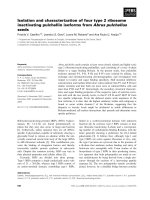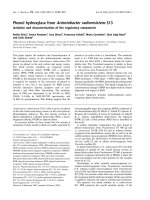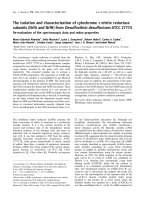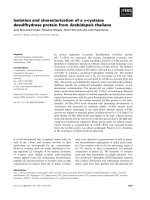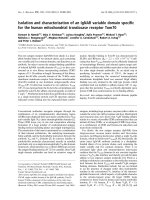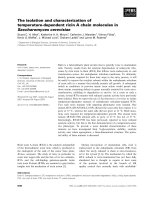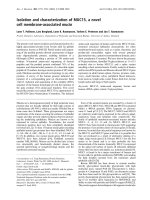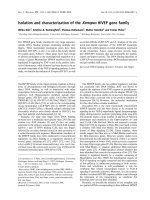Isolation and characterization of fungus associated with leaf spot of grapevines in viet nam (khóa luận tốt nghiệp)
Bạn đang xem bản rút gọn của tài liệu. Xem và tải ngay bản đầy đủ của tài liệu tại đây (1.35 MB, 52 trang )
VIETNAM NATIONAL UNIVERSITY OF AGRICULTURE
FACULTY OF BIOTECHNOLOGY
---------- ----------
THESIS
TITLE:
ISOLATION AND CHARACTERIZATION OF
FUNGUS ASSOCIATED WITH LEAF SPOT OF
GRAPEVINES IN VIET NAM
HANOI – 2022
1
VIETNAM NATIONAL UNIVERSITY OF AGRICULTURE
FACULTY OF BIOTECHNOLOGY
---------- ----------
UNDERGRADUATE THESIS
ISOLATION AND CHARACTERIZATION OF
FUNGUS ASSOCIATED WITH LEAF SPOT OF
GRAPEVINES IN VIET NAM
Student’s name
: Giap Thi Thuy Chi
Student’s code
: 620429
Class
: K62-CNSHE
Supervisor
: Dr. PHAM HONG HIEN
MSc. NGUYEN THANH HUYEN
HA NOI – 2022
COMMITMENT
I hereby declare that all the data and the results that I have provided in
this thesis are truthful, accurate, and not used in any other reports.
I also assure you that any help in this thesis has been greatly appreciated
thankful and the information cited has been acknowledged.
Hanoi, May, 2022
Student
Giap Thi Thuy Chi
i
ACKNOWLEDGEMENTS
First and foremost, I have to thank the Vietnam National University of
Agriculture for giving me a chance to study in a professional environment that
provided me the sufficient knowledge throughout four and a half academic
years.
In doing my thesis, many people helped me bring this work into
existence, but the most influential and inspiring person I would like to extend
thanks to is my supervisor, MSc. Nguyen Thanh Huyen without her assistance
and dedicated involvement in every step throughout the thesis, this thesis would
have never been accomplished.
I would like to express my deep gratitude to all teachers from the Faculty
of Biotechnology, who encouraged me to enhance my knowledge and help me
get orientation for my thesis.
Getting through my undergraduate thesis required more than academic
support, and I have many, many people to thank for listening to and, at times,
having to tolerate me, thank all my friends, who were with me up until this
point, simultaneously motivate me to accomplish more.
Last but not least, I would like to thank myself, and my parents who
endured this long process, for always supporting and assisting me during the
process of completed graduate thesis.
Ha Noi, May, 2022
Student
Giap Thi Thuy Chi
ii
ABSTRACT
Grapevine (Vitis spp.) is among the most widely grown fruit crops
worldwide and plays a significant role in its commercial value in Vietnam as
well as having an excellent source of nutrition. However, recently many diseases
appeared and affected the yield and quality such as downy mildew (Plasmopara
viticola), powdery mildew (Uncinula necator), and leaf spot (Phomopsis
viticola). Among them, leaf spot disease is a fairly common disease and causes a
significant reduction in the yield of Grapevines.
The thesis was conducted in leaf spots of grapevines collected from
different places in Ha Noi and Bac Giang, Vietnam in 2021. The fungus was
Isolated from leaf spot disease on grapevines, and the fungus was selected and
then used for artificial infection into healthy grapevine leaves. The fungal strains
causing the grape leaf spots will be selected to study the morphological and
biochemical characteristics, as well as the conditions affecting the growth of the
fungus. Then, these fungal strains are identified by molecular tools.
Research results show that 2 strains (SM and HV) of fungi have been
isolated, but after re-infection, only one strain (SM) is capable of causing leaf
spot disease on grape leaves, SM strain has mycelium that is profusely branched
(monopodial branching).
Studying the growth conditions of fungal strains proves that SM grows
well on MEA and PDA, at around the temperature range of 20-30°C with pH
from 5.0 to 8.0. SM strain has the ability to produce chitinase, cellulase, and
pectinase.
The causal fungus strain (SM) was identified as Phomopsis viticola.
iii
INDEX
COMMITMENT ................................................................................................... i
ABSTRACT ........................................................................................................ iii
LIST OF ABBREVIATIONS ............................................................................. vi
LIST OF TABLES ............................................................................................. vii
LIST OF FIGURES ........................................................................................... viii
I. INTRODUCTION .............................................................................................1
1.1. Introduction .................................................................................................1
1.2. Research purpose ........................................................................................2
1.3. Requirement ................................................................................................2
II. LITERATURE REVIEW .................................................................................2
2.1. General introduction of grapevines .............................................................2
2.1.1. Distribution ...........................................................................................4
2.1.2. Description of morphological characteristics of the grapevine ............5
2.1.3. Nutrients ................................................................................................6
2.1.4. Uses .......................................................................................................7
2.2. Grapevine pathogens ..................................................................................8
2.2.1. Downy mildew (Plasmopara viticola) .................................................8
2.2.2. Powdery mildew (Uncinula necator) ................................................ 10
2.2.3. Leaf spot (Phomopsis viticola) .......................................................... 11
2.3. Commercial production............................................................................ 14
III. MATERIALS AND METHODS ................................................................. 17
3.1. Materials ................................................................................................... 17
3.1.1. Sample collection ............................................................................... 17
3.1.2. Chemicals and medium components ................................................. 17
3.1.3. Laboratory apparatuses and equipment ............................................. 19
3.1.4. Research location and time ............................................................. 19
3.2. Methods .................................................................................................... 19
3.2.1. Isolation of fungus causing leaf spot disease on grapes (Chomnunti et
al. ,2014) ...................................................................................................... 19
iv
3.2.2. Artificial infection (Jayawardena, Ruvishika S., et al.,2016)............ 19
2011) ............................................................................................................ 20
3.2.4. The effects of some factors on fungal growth (culture medium,
temperature, and pH ) .................................................................................. 20
3.2.5. Extracellular enzyme production of isolated fungal strain ................ 21
3.2.6. DNA extraction, PCR amplification and Sequencing ....................... 22
3.2.7. Phylogenetic analysis ......................................................................... 23
IV. RESULTS AND DISCUSSION .................................................................. 24
4.1. Isolation of fungal pathogens causing leaf spots from grapevines leaf ... 24
4.2. Artificial infection .................................................................................... 25
4.3. Morphological characteristics of SM strain ............................................. 25
4.4. The effects of culture medium on SM strain growth ............................... 27
4.5. Effect of different temperatures on the growth of SM strain................... 28
4.6. Effect of different pH on the growth of SM strain .................................. 29
4.7. Testing extracellular enzyme activity ...................................................... 30
4.8. DNA extraction, PCR amplification and Sequencing and Phylogenetic
analysis ............................................................................................................ 33
4.8.1. DNA extraction, PCR amplification of SM strain ............................. 33
4.8.2. Phylogenetic analysis of SM strain.................................................... 34
V. CONCLUSION AND SUGGESTION ......................................................... 36
5.1. Conclusion................................................................................................ 36
5.2. Suggestion ................................................................................................ 36
REFERENCES ................................................................................................... 37
v
LIST OF ABBREVIATIONS
Abbreviations
Explanations
PDA
Potato Dextrose Agar
SDA
Sabouraud Dextrose Agar
MEA
Malt Extract Agar
CDA
Czapek Dox Agar
WA
Water Agar
ISP
International Streptomyces Project
et al
Et alia
CWDEs
CMC
cell wall-degrading enzymes
Carboxymethyl cellulose
vi
LIST OF TABLES
Table 2.1. Nutrition of Grapes .............................................................................. 6
Table 3.1. Experimental materials for detecting extracellular enzymes............. 18
Table 4.1. Morphological characterization of two isolated fungal strains ......... 24
Table 4.2. The ability of extracellular enzyme production of SM ..................... 31
vii
LIST OF FIGURES
Figure 2.1. One grapevine garden in Ninh Thuan ................................................ 5
Figure 2.2. Symptoms of powny mildew disease ................................................ 9
Figure 2.3. Symptoms of powdery mildew disease ........................................... 11
Figure 2.4. Symptoms of leaf spot disease ........................................................ 13
Figure 3.1. Leaf samples with leaf spot disease ................................................. 17
Figure 4.1. Fungal strains isolated from infected grape leaves .......................... 24
Figure 4.2. Re-infection of isolated fungal strains (HV, SM) in grapevine leaf
and control sample on the 3rd days ...................................................................... 25
Figure 4.3. Microscopic observation of the selected fungus strain-SM ............. 26
Figure 4.4. Growth of SM strain in different media on the 5th days ................... 27
Figure 4.5. Growth of SM strain in different temperatures on the 5th days ........ 28
Figure 4.6. Growth of SM strain in different pH on the 5th days........................ 30
Figure 4.7. Chitinase activity of the SM strain ................................................... 31
Figure 4.8. Cellulase activity of the SM strain ................................................... 32
Figure 4.9. Pectinase activity of the SM strain ................................................... 32
Figure 4.10. PCR product of SM strain on gel agarose ...................................... 33
Figure 4.11. Phylogenetic tree of SM strain ....................................................... 34
viii
I. INTRODUCTION
1.1. Introduction
Grapevine (Vitis sp., Vitaceae) is one of the most important fruit crops
cultivated around the globe and has a high nutritional value in many countries.
According to FAO data (2014), the global grape-growing area has 8,485,000
hectares and is increasing at a pace of 2% per year, with yearly production
reaching 60,473 million tons, accounting for 17.5 percent of total global fruit
production. Approximately 71% of grapes are utilized as raw materials for wine
production, 27% are consumed fresh, and 2% are dried (seedless grapes).
Currently, vines are grown on all five continents in climates that are
conducive to their growth. Spain (1,175,000 ha), Russia, Italy, France, Turkey,
Portugal, and the United States are the countries with the largest grape areas in
the world. Over 60% of the world's grape output has been produced in Europe.
In recent years, grape acreage and production have expanded in Asia. The entire
area is currently around 1.7 million hectares. China, India, Japan, Korea,
Pakistan, Thailand, and Vietnam are Asian countries having substantial grape
acreage (FAO, 2014).
According to the conference on grape production in Asia Pacific
countries, which included eight countries: China, India, Korea, Japan,
Myanmar, Thailand, and Vietnam, the grape area of the participating countries
is 393,725 ha, with a yield of 5.432 million tons and an average grape yield of
13.6 tons per ha per year. The grape output in Vietnam is lower than the
regional average, at only 11.2 tons per hectare per year (caytrong, 2019).
In Viet Nam, there are also many grape growing regions, of which Ninh Thuan
is the most planted with about 2,400 hectares in Ninh Thuan (accounting for
90%) and 250 hectares in Binh Thuan (accounting for 9% of the total grape
growing area of the country) (Le Quang Quyen et al., 2019). The results of a
random survey of 50 vineyards with different planting ages in 2014 showed that
1
the average grape yield in Ninh Thuan was over 30tons/ha/year. Growing
grapes can make a profit of over 200-300 million VND/ha/year (Tran Ngoc Tu
et al., 2015).
Although it has great economic value, currently the yield and quality of
vines are reduced due to several diseases such as downy mildew (Plasmopara
viticola (Berk. & MA Curtis) Berl. & De), anthracnose (Elsinoe ampelina
Shear), leaf spots (Phomopsis viticola) and Cooked Rot (Glomerella cingulata
(Stoneman) Spauld & Schrenk). Currently, there are many measures to control
diseases on grapevines, but measures Using chemical drugs are widely applied
because of their quick effect. However, the long-term use of chemical drugs
causes serious health consequences.
For the above reasons, the topic " Isolation and characterization of fungus
associated with leaf spot of grapevines in Viet Nam " was carried out. This
study was undertaken for the evaluation of the characteristics of pathogenic
fungal strains and will provide useful information to find solutions. Effective
disease prevention while maintaining the nutritional value of grapes without
affecting the health of the user.
1.2. Research purpose
- Isolation of fungal strains causing leaf spot disease on grapes in Vietnam.
- Determination of the morphological, and biochemical characteristics of
the pathogenic fungus causing grape leaf spot spots Vietnam.
1.3. Requirement
- Isolation and selection of fungus associated with leaf spots in grapevine
leaves
- Pathogenicity test on healthy grapevine leaves.
- Characterization of fungal strain causing leaf spot in grapevine leaves:
morphology colony, mycelium, and spore of fungus.
2
II. LITERATURE REVIEW
2.1. General introduction of grapevines
The grapevine (Vitis vinifera) belongs to the Vitaceae family, which
includes approximately 60 inter-fertile wild Vitis species found in Asia, North
America, and Europe under subtropical, Mediterranean, and continental–
temperate climatic conditions. It is the single Vitis species that has gained
significant economic interest and is a commercially valuable plant over time,
which can be used as a rich source of nutrients in multiple industries (Xu et al.
2017; Chitarrini et al., 2017), for example, the North American, are used as
breeding rootstock due to their resistance against grapevine pathogens, such as
Phylloxera, Oidium and mildews. Indeed, a great majority of cultivars are
widely cultivated for fruit, juice, and mainly for wine which was classified as
Vitis vinifera L. subsp. Vinifera (or Sativa), derive from wild forms (Vitis
vinifera L. subsp. sylvestris (Gmelin) Hegi] ((Rossetto, McNally et al., 2002);
(Sefc, Steinkellner et al., 2003); (Crespan, 2004, This, Jung et al., 2004).
According to Nikolai Ivanovich Vavilov (1926), a Russian botanist work
of prominent, the highest biodiversity of a crop is usually its center of origin. In
1938, his disciple Aleksandr Mikhailovich Negrul observed that the highest
biodiversity in cultivated grapes was in today’s Georgia, Armenia, Azerbaijan,
Turkey, and Iran, which makes them the best candidates for being the cradle(s)
of viticulture.
Analysis of morphological similarities between wild and cultivated grapes
from all over Eurasia generally supports a Near Eastern origin for grape
domestication. The closest genetic relationship was discovered between local
wild grapevines and traditionally cultivated grape varieties from southern
Anatolia, Armenia, and Georgia. This suggests that the headwaters of the Tigris
and Euphrates rivers in the Taurus Mountains are the most likely location for the
first domestication of the grapevine (Arroyo‐García, R., et al., 2006).
2
Grapevine was domesticated (Vitis vinifera, sometimes called V. sativa)
and was one of the most important fruit species in the classic Mediterranean
world, and it is the most important economic fruit species in the modern world
today. As in the ancient past, sun-loving grapevines are today cultivated to
produce fruits, which are eaten fresh (as table grapes) or dried (as raisins), and,
most especially, to make wine, a drink of great economic, cultural, and symbolic
value (K. Kris Hirst, 2018).
The Vitis family consists of about 60 inter-fertile species that exist almost
exclusively in the Northern Hemisphere: of those, V. vinifera is the only one
extensively used in the global wine industry. Approximately 10,000 cultivars of
V. vinifera exist today, although the market for wine production is dominated by
only a handful of them. Cultivars are typically classified according to whether
they produce wine grapes, table grapes, or raisins (K. Kris Hirst, 2018).
Domesticated grapevine (Vitis vinifera, also known as V. sativa) was one
of the most important fruit species in the classic Mediterranean world, and it
continues to be the most important economic fruit species in the modern world.
Sun-loving grapevines are cultivated today, as they were in the past, to produce
fruits that are eaten fresh (as table grapes) or dried (as raisins), and, most
importantly, to make wine, a drink with significant economic, cultural, and
symbolic value (K. Kris Hirst, 2018).
The Vitis family consists of approximately 60 inter-fertile species that
exist almost entirely in the Northern Hemisphere; of these, V. vinifera is the only
one that is widely used in the global wine industry. There are approximately
10,000 V. vinifera cultivars in existence today, but only a few of them dominate
the wine production market. Cultivars are typically classified based on whether
they produce wine grapes, table grapes, or raisins (K. Kris Hirst, 2018).
3
2.1.1. Distribution
Currently, in the world, the area under grape cultivation reaches 7.4
million hectares (M ha). Spain is the biggest country with 969 thousand hectares
(k ha), followed by China (875 k ha), France (789 k ha), and Italy (702 k ha)
(OIV, 2018).
In Asia, the area and production of grapes have increased in recent years.
Currently, the total area is about 1.7 million hectares. The Asian countries with
significant grape acreage are China, India, Japan, Korea, Pakistan, Thailand, and
Vietnam. According to the conference on grape production in Asia Pacific
countries including 8 participating countries: China, India, Korea, Japan,
Myanmar, Thailand, and Vietnam, the grape area of the participating countries is
393,725 ha, yield 5.432 million tons, average grape yield is 13.6 tons/ha/year.
Vietnam's grape yield is lower than the regional average, reaching only 11.2
tons/ha/year. The region from North Binh Thuan to South Khanh Hoa,
especially Ninh Thuan province, is located in the driest region in the country,
with a lot of wind, low humidity (average 70-75%), low rainfall (<800mm/year).
This is a favorable condition for vines to grow and develop well. As a result, in
Ninh Thuan, grapes soon became commodity and specialty crops from the mid80s of the last century. It plays an important role in agriculture and the
province's economy. The south-central province, which has the least rainfall in
the country, has more than 1,200 ha of grape growing areas with an annual total
output of 30,000 tonnes, with the red cardinal and the NH01-48 greencardinala
the two major grape varieties. The province’s grape farming area accounts for
less than 4% of its farming area, but the revenue contributes 15-20% of its total
crop revenue, according to the Department of Agriculture and Rural
Development.
4
Figure 2.1. One grapevine garden in Ninh Thuan
(source: Báo nông nghiệp Việt Nam)
The vineyards produce large berries with black, red, purple, and blue
colors and are a specialty of Ninh Thuan. The province's grape growing area is
about 2,500 hectares, concentrated mainly in Ninh Phuoc and Ninh Hai districts
and Phan Rang - Thap Cham town, in communes and towns of Phuoc Dan,
Phuoc Huu, and Phuoc Son with many new grape varieties. Since 2002, Ninh
Thuan has expanded the vine area from 25 to 30 hectares and since 1995 the
area has increased fastest to over 2,000 hectares. The locality has a plan to
develop vines from 1,000ha -2,000ha in 2015 and 2,500ha in 2020.
Ninh Thuan is a supplier of fresh grapes with the largest production in the
country, averaging about 15,000 tons/year and processing many products such
as dried grapes, grape jam, grape wine, grape nectar... of consumers in which,
every year farmers of Ninh Thuan province, export over 10,000 tons of fresh
grapes to other provinces in the region.
2.1.2. Description of morphological characteristics of the grapevine
The grapevine (Vitis vinifera L.) is a vine cultivated worldwide for its
edible berries (grapes) that are eaten fresh or pressed to make wine or grape
juice. An important by-product of the grape crop is the leaves and shoots that are
5
pruned once a year for crop management. Grape leaves and vine shoots have
been used traditionally to feed livestock in vineyards, particularly in
Mediterranean countries.
The grapevine is a vigorous and climbing woody vine that can reach a
height of 15-20 m in the wild. In cultivated vines development is dramatically
reduced through yearly pruning of shoots and leaves. Grape leaves are simple
circular or circular ovate in outline, 5-25 cm broad, with long petioles. They can
be entire or lobed (3 to 5 lobes) and coarsely toothed. The inflorescence bears
small, pentamerous, fragrant, yellow-green flowers. The fruits are ellipsoid or
globose berries, 6-25 mm long, of variable colors (from green, yellow to dark
blue-purple) depending on the variety. Fruits (grapes) are juicy, sweet ,or sour.
They contain 3-4 seeds (Edward W. Hellman, 2017). In viticulture, the shoot is
the vegetative stem of the current year that bears the leaves, tendrils, and fruit.
The cane is the vine shoot from the period it matures (turns brown and woody)
until the end of the second year of growth (Jackson, 2008).
2.1.3. Nutrients
Grapes, particularly the Concord grape variety, contain phytonutrients
such as phenols, polyphenols, resveratrol, and carotenoids. Grapes are also a
good source of vitamin K, copper, and many B vitamins, adding that they are
also high in fiber and low in calories.
Table 2.1. Nutrition of Grapes
Amt per Serving
%DV
Amt per serving
%DV
Total Fat 0g
0%
Total Carbohydrate 27.3g
9%
Cholesterol 0mg
0%
Dietary Fiber 1.36g
5%
Sodium 3mg
0%
Sugars 23.4g
Vitamin A
2%
Calcium
2%
Vitamin C
27%
Iron
3%
Protein 1g
( Source: Candy Hearts® Grapes used with permission from IFC )
1 cup (151 g) Calories 104 Calories from Fat 2; Percent Daily Values (%DV) are based on a
6
2,000calorie diet.
Grapes contain 13 calories per 14 g serving. This serving contains 0.3 g of
fat, 0.8 g of protein, and 2.4 g of carbohydrates. The latter is 0.9 g of sugar and
1.5 g of dietary fiber; the rest is complex carbohydrates. Grapes contain 0 g of
saturated fat and 0 mg of cholesterol per serving. 14 g of raw grape leaves
contains IU vitamin A, 1.6 mg vitamin C, and 0.00 mcg vitamin D, as well as
0.37 mg iron, 50.82 mg calcium, and 38 mg potassium.
2.1.4. Uses
In vineyards, grape leaves and shoots are pruned after the grapes are
harvested. These residues are generally disposed of by mulching into the
vineyard or by burning on-site (Letaief, 2016). In the Mediterranean Basin,
leaves and shoots are traditionally browsed by sheep and goats (Magnier, 1991).
In Turkey, grape leaves are an important source of forage for ruminants during
the critical period when the quality and quantity of pastaree is limited (Kamalak,
2005). Ensiled grape crop residues have been recommended as fodder since the
end of the 19th century (Pau, 1940). Generally, grape leaves and shoots are
fibrous products that can only be eaten by ruminants, equids, and rabbits. Grape
leaves are also used for food in many countries in the Mediterranean area,
Eastern Europe, and Asia. Grape leaves stuffed with rice are delicacies known as
"yaprak dolma" in Turkey, "dolmeh barg mo" in Iran, and "warak enab" in
Egypt and Lebanon (Bekhit et al., 2016). Grape leaves and shoots have been
reported as a potential source of natural antioxidants and as a food supplement
(Cetin et al., 2011).
The grape is one of the world's most important fruit crops in the area,
production and value. In 2012, grapes were cultivated on more than 7 million ha
and produced 69 million t of fruits, with an average yield of 9.6 t/ha. 40 million t
of grapes were used for the production of wine (about 90%) and juice (around
10%, fresh or concentrated), 24 million t for fresh fruit, and 5 million t for dried
7
grapes (raisins) (OIV, 2016; Castellucci et al., 2013). The most important
producers were China (9.6 million t), the USA (6.6 million t), Italy (5.8 million
t), France (5.3 million t), Spain (5.2 million t), Turkey (4.2 million t), Chile (3.2
million t), Argentina (2.8 million t) and Iran (2.1 million t). The EU represents
75% of grape production and 57% of wine production. The main wine producers
are Italy, France, Spain (where most of grape production is used for wine) and
the USA. China is mostly a producer of fresh fruits (FAO, 2016).
2.2. Grapevine pathogens
For farmers, grapevine diseases can be devastating to the productivity and
quality of vines. Unfortunately, many kinds of vine diseases thrive in all sorts of
conditions. Many of the grapevine parasites are of animal origin (insects and
mites) or vegetal origin (cryptogram or parasitic fungi). The most common
fungal diseases are downy and powdery mildew (Plasmopara viticola and
Uncinula necator), and leaf spot (Phomopsis viticola). On the other hand, the
most dangerous insects are the grape moth (Lobesia botrana), vine mealybug
(Planococcus ficus), and the citrus mealybug (Planococcus citri).
2.2.1. Downy mildew (Plasmopara viticola)
The downy mildew was introduced in France from North America in
1878. It moved into Italy the following year and subsequently into the other
countries of the Mediterranean basin. Furthermore, it was introduced into
Australia in 1919 and into New Zealand in 1926.
The symptoms of this pathogen differ somewhat on different hosts.
However, they all cause yellow spots on the upper leaf surface between the leaf
veins. These spots spread everywhere but the veins and eventually turn brown.
The plant cannot photosynthesize on these yellow or brown spots. When the leaf
is totally brown, it drops. Today downy mildew is present in all vine cultivation
areas. The downy mildew is the most prevalent form of mildew and is usually
8
spread by rainfall. It attacks leaves, shoots, and berries and can quickly defoliate
the vine leading to the loss of the entire crop. When the leaf is totally brown, it
drops. If the plant loses too many leaves, the plant dies. Optimum conditions for
primary infection take place at 10:10:10, which corresponds to at least 10 mm of
rain at a temperature of 10oC or more, over 10 h.
Figure 2.2. Symptoms of powny mildew disease
(source: />
Fungus (Plasmopara viticola), the causal agent of grapevine downy
mildew, is a heterothallic oomycete that overwinters as oospores in leaf litter
and soil. In the spring, oospores germinate to produce macrosporangia, which
under wet conditions release zoospores. Zoospores are splashed by rain into the
canopy, where they swim to and infect through stomata. After 7–10 days, yellow
lesions appear on the foliage. During favorable weather, the lesions sporulate
and new secondary infections occur.
Downy mildew can be controlled by spraying various chemicals either as
preinfection or postinfection treatments. There are two groups of spray
chemicals, those with a single-site activity that acts on only one site within the
fungus organism, or those with multisite activity, which work on more than one
site within the fungus. The most used multisite chemicals for the preventive
9
control of downy mildew are copper salts such as copper oxychloride. In the
past several years, the overuse of chemicals has led to small mutational changes
within the fungus, which can lead to the fungus being resistant.
Downy mildew is currently causing heavy damage to grape yield and the
use of some drugs such as metiram, mancozeb, folpet, tolylfluanide are
commonly used to combat Downy mildew is becoming more and more
common.
2.2.2. Powdery mildew (Uncinula necator)
The powdery mildew is a pathogen that was brought into England from
North America in 1845. Subsequently, powdery mildew was introduced into
France in 1847, Belgium in 1848, and finally Italy in 1849.
Symptoms usually appear later in the growing season on outdoor plants.
Powdery mildew starts on young leaves as raised blister-like areas that cause
leaves to curl, exposing the lower leaf surface. Infected leaves become covered
with a white to gray powdery growth, usually on the upper surface; unopened
flower buds may be white with mildew and may never open. Leaves of severely
infected plants turn brown and drop. The disease prefers young, succulent
growth; mature leaves are usually not affected. All aerial parts of the plants can
get infected by this disease. Development happens through the entire growing
season until late fall. It favors dry years and climates with low humidity and
little rainfall. Moldy coats on leaves, inflorescences, and rachis are telltale signs.
Berries can become infected in the early stages of their development, with a gray
coat covering them and then they dry out afterward. Infected half-ripe berries
usually crack and dry out. The plant’s canes can also become covered with a
gray coating with gray-brown spots underneath.
10
Figure 2.3. Symptoms of powdery mildew disease
(Source: />
Powdery mildew of grapes is caused by a fungus Uncinula necator. It is a
common pathogen of Vitis species, including the wine grape, and Vitis vinifera.
The fungus is believed to have originated in North America, A gray-white,
dusty, fungal growth consisting of mycelia, conidia, and conidiophores coats
much of the infected plant. Chasmothecia, which are the overwintering
structures, present themselves as tiny, spherical fruiting structures that go from
white to yellowish-brown to black in color, and are about the size of the head of
a pin.
To control this pathogen, genetic resistance, chemical methods, and
careful farming are used to manage conditions. Fungicides are used as well as
silicon, which assists plant cells in fighting against the fungus and strengthening
the epidermal cells of the plants. There are no approved fungicides for
postinfection treatments.
2.2.3. Leaf spot (Phomopsis viticola)
Leaf spots are a type of plant disease that is usually caused by fungus and
sometimes other cases such as herbicide injuries. Leaf spots can vary in size,
11
shape and colours depending on the age and type of the cause or pathogen.
Grapevines are weakened by the spots on the leaves as they reduce available
foliar space for photosynthesis.
The causes of leaf spots are mainly Phomopsis viticola (Sacc.) Sacc. is
historically known to infect grapevines (Vitis vinifera and Vitis spp.) causing
leaf spot disease. However, leaf spots may also be caused by abiotic factors such
as environmental conditions, toxicities and herbicide injuries (Isleib, 2012).
Leaf symptoms appear early in the growing season and are characterized
by small brown necrotic spots around the veins and brown “U- or V-” shaped
lesions at the margins of the leaf blade. Under humid conditions, abundant gray
sporulation can be observed on the underside of the diseased leaf tissues. to
black necrotic irregular-shaped lesions, and clusters show rachis necrosis and
brown, shriveled berries close to harvest (Hewitt, W. B., and Pearson, R. C. ,
1988)
Leaf spot is a well-studied grapevine disease, and much has been written
about its etiology (Mostert, L., Crous, P. W., Kang, J. C., and Phillips, A. J. L. ,
2001), epidemiology (Erincik, O., Madden, L. V., Ferree, D. C., and Ellis, M.
A., 2003.).
Certain chemicals are used to treat leaf spot disease, such as the Bordeaux
mixture, the first fungicide to have been developed, which treats many fungal
and bacterial leaf spots (Agrios, G. N., 2005). Other fungicides such as zineb,
chlorothalonil and Captan, also treat leaf spot disease and Benomyl specifically
treats Cercospora leaf spots, cherry leaf spot and black spot of roses(Agrios, G.
N. , 2005).
12
Figure 2.4. Symptoms of leaf spot disease
A. Grape leaf spot symptoms, B. conidia with conidiophores of Phomopsis viticola, C.
conidia Phomopsis viticola
(Source: />
Some studies around the world indicate that: Phomopsis viticola (Sacc.)
Sacc. is the causal factor of grape leaf spot (Vitis spp.) (Schilder, Erincik et al.,
2005). The fungus can infect all green grapevine parts and overwinters in the
bark of older canes. The most common symptom of the disease is dark brown
lesions on the shoots and leaves. Cluster symptoms usually appear as the fruit
begins to ripen: rachises become necrotic and berries rot or fall to the ground
(Schilder, Erincik et al., 2005). Some other studies also show that Phomopsis sp.
is the causative agent of leaf spot disease: (Merrin, Nair et al., 1995) published a
study on Phomopsis from grapevines in Australia. Phomopsis was also isolated
from grapes (Vitis spp.) showing symptoms of leaf spot in Ohio, Michigan, New
York, Pennsylvania, Maryland, and Ontario (Canada) (Schilder, Erincik et al.,
2005). Severe rachis and berry infections were observed in a 'Vignoles' (Vitis
interspecific hybrid) vineyard in southwestern Michigan in 1998 and 1999.
Besides, During the 2002 to 2004 growing seasons, a statewide survey for the
incidence of leaf spot of grape (caused by Phomopsis viticola) was conducted
within vine on disease incidence. Disease was observed in all surveyed
13
vineyards over a three-year period, with a mean disease incidence of 42 and 50
percent for leaves and internodes, respectively.
Not only that, Phomopsis leaf spot incidence and severity can differ
greatly from season to season (Schilder, Erincik et al., 2005). Seasonal
differences in disease have generally been attributed to variability in
environmental conditions such as rainfall and temperature, but little is known
about the specific effects of the environment on Phomopsis leaf spot
development. Disease incidence and severity have been reported to be higher in
wet growing seasons than in dry ones (Willison, Chamberlain et al., 1965).
Prolonged rainy weather, particularly in early spring when new shoots emerge,
has been found to be very conducive to infection. (Schilder, Erincik et al., 2005)
linked early-season infections to low (presumably below-normal) temperatures
during this time period. They claimed that the fungus was only active at low
temperatures and that as temperatures rose, the fungus became inactive,
resulting in no infection later in the growing season. Bugaret (1984) was the first
to explore the effect of temperature and wetness duration on foliar infection by
Phomopsis viticola. He stated that the ideal temperature for infection was
between 23 and 25°C. He also reported that the average temperature at bud
break in the spring ranged from 8 to 18 °C, which is significantly lower than the
optimum observed in his studies. He also confirmed that at the optimum
temperature, infection requires at least 4 hours of wetness.
2.3. Commercial production
Like the rest of the global agricultural sector, the table grape industry has
had to face a variety of challenges related to the COVID-19 pandemic this past
year, including soaring freight costs, labor shortfalls, worldwide shipping delays
and refrigerated container shortages. In Peru, worker strikes hampered then in
Chile, unseasonal downpours in January led to losses of up to 80% in the
O’Higgins Region, the country’s largest grape production areimilar to , the
14

